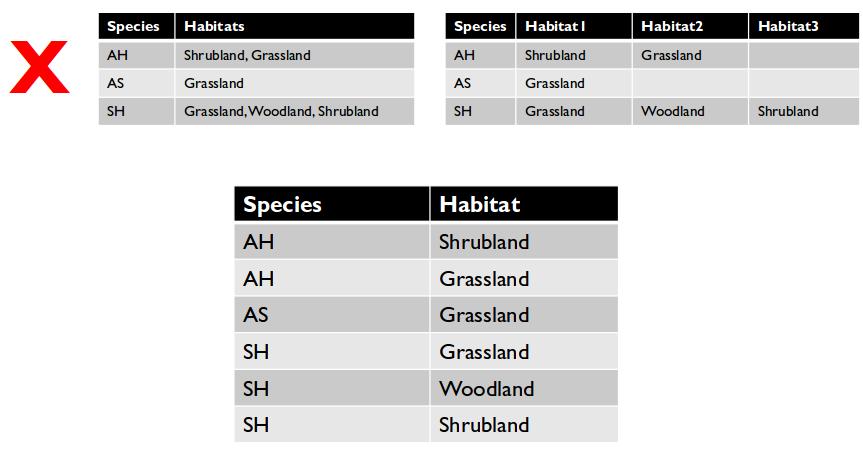Overview
Teaching: 5 min Exercises: 5 minQuestions
What is tidy data structure?
How do I use
tidyrto restructure messy data?Objectives
To understand the importance of tidy data structure
To tidy our data in preparation for the final figure
Tidy data structure rules:
- Order doesn’t matter
- No duplicate rows
- Every cell contains one value
- One column per type of information
- No redundant information
Restructure tables with messy data.

Important tidyr functions:
- gather()
- separate()
Gapminder data time series is stored cross-tabulated.
tidyrFill-in ChallengeFill in the missing pieces of the following code to generate a tidy data table.
pop_by_continent <- ________ %>% gather(year, population, ________) %>% separate(________, c("pop", "year"), sep = "_") %>% select(continent, country, ________, ________)Output Solution
> str(pop_by_continent) 'data.frame': 1704 obs. of 4 variables: $ continent : Factor w/ 5 levels "Africa","Americas",..: 1 1 1 1 1 1 1 1 1 1 ... $ country : Factor w/ 142 levels "Afghanistan",..: 3 4 11 14 17 18 20 22 23 27 ... $ year : chr "1952" "1952" "1952" "1952" ... $ population: num 9279525 4232095 1738315 442308 4469979 ... > head(pop_by_continent) continent country year population 1 Africa Algeria 1952 9279525 2 Africa Angola 1952 4232095 3 Africa Benin 1952 1738315 4 Africa Botswana 1952 442308 5 Africa Burkina Faso 1952 4469979 6 Africa Burundi 1952 2445618Code Solution
pop_by_continent <- data %>% gather(year, population, pop_1952:pop_2007) %>% separate(year, c("pop", "year"), sep = "_") %>% select(continent, country, year, population)
dplyrReview Fill-in ChallengeFill in the missing pieces of the following code to filter data for 2007.
pop_2007 <- filter(________)Output Solution
> str(pop_2007) 'data.frame': 142 obs. of 4 variables: $ continent : Factor w/ 5 levels "Africa","Americas",..: 1 1 1 1 1 1 1 1 1 1 ... $ country : Factor w/ 142 levels "Afghanistan",..: 3 4 11 14 17 18 20 22 23 27 ... $ year : chr "2007" "2007" "2007" "2007" ... $ population: num 33333216 12420476 8078314 1639131 14326203 ... > head(pop_2007) continent country year population 1 Africa Algeria 2007 33333216 2 Africa Angola 2007 12420476 3 Africa Benin 2007 8078314 4 Africa Botswana 2007 1639131 5 Africa Burkina Faso 2007 14326203 6 Africa Burundi 2007 8390505Code Solution
pop_2007 <- filter(pop_by_continent, year==2007)
Key Points
Tidy data has one value per cell and all similar values in a single column.